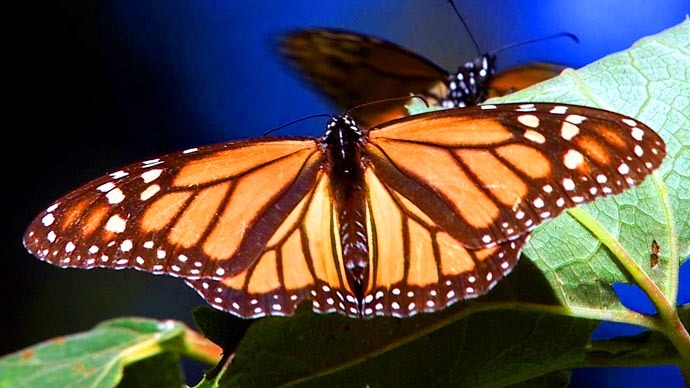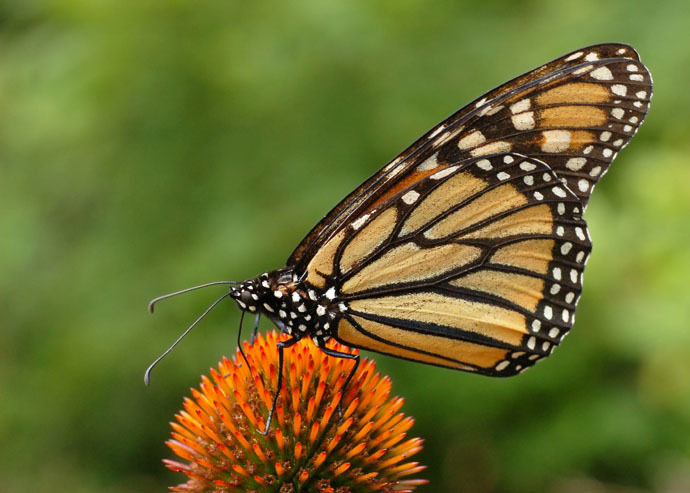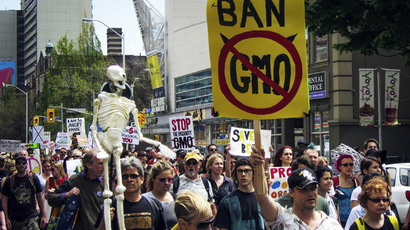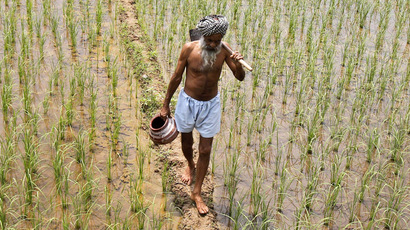Monsanto monarch massacre: 970 million butterflies killed since 1990

The beautiful monarch butterfly, which is also a major pollinator, is being threatened by herbicides that eradicate milkweed, its primary food source. Now, a desperate rejuvenation program is under way to save the species from possible extinction.
A shocking statistic released by the US Fish and Wildlife Service on Monday summed up the plight of the monarch butterfly: Since 1990, about 970 million of the butterflies – 90 percent of the total population – have vanished across the United States.
READ MORE: Rising suicide rate for Indian farmers blamed on GMO seeds
The massacre provides a grim testimony to the delicate balance
that exists between man and nature, and how the introduction of a
single consumer product – in this case, Monsanto’s Roundup Ready
herbicide – can wreak so much havoc. Sold to farmers and
homeowners as an effective method for eliminating milkweed
plants, Roundup Ready, introduced in the 1970s, is widely blamed
for decimating the monarch butterflies’ only source of food in
the Midwest.
“This report is a wake-up call. This iconic species is on the
verge of extinction because of Monsanto's Roundup Ready crop
system,” said Andrew Kimbrell, executive director for the
Center for Food Safety, which last week released a report describing the effects of
herbicide-resistant crops on monarch butterflies in North
America.
“To let the monarch butterfly die out in order to allow
Monsanto to sell its signature herbicide for a few more years is
simply shameful.”
The widespread death of the monarch butterfly has prompted some
groups, like the Center for Biological Diversity, to demand the
butterfly be placed on the endangered species list.
Dan Ashe, director of Fish and Wildlife Service, preferred to
take a diplomatic approach to Monsanto’s hefty contribution to
the problem, saying everyone is responsible for the plight of the
monarch butterfly.
“We’ve all been responsible. We are the consumers of
agricultural products. I eat corn. American farmers are not the
enemy. Can they be part of the solution? Yes,” Ashe said.
“It’s not about this wonderful, mystical creature. It’s about
us.”

Monsanto responded to the issue in a blog on its website by saying that listing monarch butterflies as a threatened species under the Endangered Species Act “makes for a great news headline,” but ultimately fails to “help solve the problem.”
Rejuvenation efforts
The monarch migrates annually thousands of miles - and over the lifespan of many generations - from Mexico, across the United States, to Canada. To complete this migration, the butterfly is dependent upon the milkweed plant, which provides not only a major food source, but a larval host. However, as US farmland continues to eat up the remaining wild places, there appears to be little left to sustain the monarch.
In an effort to restore monarch numbers, the US Fish and Wildlife
Service has teamed up with the National Wildlife Federation and
the National Fish and Wildlife Foundation to start a milkweed
replanting program.
The Fish and Wildlife Service said it will contribute $2 million
this year to restoring more than 200,000 acres of monarch
habitat, while also “supporting over 750 schoolyard habitats
and pollinator gardens.” The service will also concentrate
rejuvenation efforts on Interstate 35, a 1,568-mile (2,523 km)
highway that extends from Texas to Minnesota, which closely
follows the monarch’s migration path.
“We can save the monarch butterfly in North America, but only
if we act quickly and together,” said Ashe.
The monarch butterfly is not the only pollinator species
suffering from the agricultural use of pesticides. Wasps, beetles
and especially honeybees have all experienced significant drops
in their numbers over the years, which will have adverse effects
on America’s crop supply if not soon addressed.
Monsanto controversy
Monsanto has run into controversy before over its glysophate-based Roundup Ready product. It is even being blamed by some for a sharp spike in suicide rates among Indian farmers, many of whom could not afford to continue buying the Ready Roundup seeds and herbicides.
READ MORE: World protests Monsanto grip on food supply chain
The Indian farmers would not receive a loan “if they don’t go
with the GMOs,” the head of the Council for Responsible
Genetics, Sheldon Krimsky, told RT. “And many of them felt coerced
to take the GM seeds. The GM crops have not done as well in all
regions of India... [That has led to] much greater indebtedness
with the GM crops that did not perform as well.”
Monsanto denies that its seeds have contributed to the plight of
Indian farmers.
“Despite claims by those who oppose GMO crops, research also
demonstrates there is no link between Indian farmer suicides and
the planting of GMO cotton,” the company said on its
website.
However, since Monsanto controls about 95 percent of the cotton
seed market in India, many small farmers are falling behind on
their debt, leading them, critics claim, to desperate measures.
“Two hundred and eighty-four thousand farmers have committed
suicide in India because of debt linked to seed and
chemicals,” Vandana Shiva, an Indian environmental activist
and anti-globalization author, said last year ahead of the March
Against Monsanto global protests.
No #scientific consensus on #GMO#safetyhttp://t.co/tXRF7prsMQ@PrakashJavdekar
— Dr. Vandana Shiva (@drvandanashiva) January 28, 2015
“Monsanto have claimed more than 1,500 climate resilient
patents, and are hoping to use the climate crisis to make even
bigger profits,” Shiva says claiming that “Monsanto
wants super profits through total control over nature and
humanity.”
Last year, hundreds of thousands of people united around the
world to raise awareness over the biotech giant Monsanto’s
growing grip on the global food supply chain.
Activists on five continents around the globe, comprising 52
nations, joined the fight under the March against Monsanto
umbrella.














